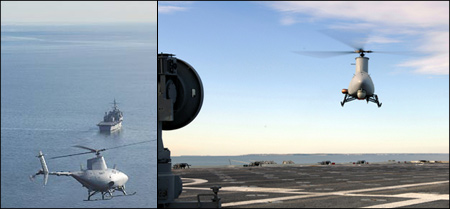
An RQ-8A Fire Scout rotor UAV landed on a moving Navy ship in what was apparently the first autonomous landing (as opposed to a net capture) of an unmanned aircraft on a ship.
Posted by jjwiseman at January 19, 2006 01:52 PMOn day one of the testing at 11:51 a.m., the green light was established as all systems were "go" on land and on sea. Under the command of the shore-based ground control station (GCS), the RQ-8A Fire Scout lifted off from the shore, and began its autonomous route to the ship. The shore-based GCS handed off control to the shipboard GCS, and after establishing telemetry data, a series of ever-closer approaches to the ship were conducted. In accordance with the test plan script, the RQ-8A Fire Scout came aboard the USS Nashville for the first autonomous landing at 2:42 p.m.
I am delighted to see the post about the Firescout landing on the ship. I am one of the designers of the radar sensor (you can see it in the foreground of the close-in photo). The sensor provides ship relative positioning with 1 foot accuracy and very accurate ship motion stabilization data, which is uplinked to the UAV. Position/motion sensing is the big problem landing on a ship. GPS is not nearly good enough, not yet anyway. You can see some videos of other UAV landings at the company website, http://www.sncorp.com/uav.html#.
However, one note is that there has been a previous autoland of a UAV rotorcraft on a ship, using the same sensor. That was in the late 90's. Pick the 'CL327' video to see that landing. That program was canceled so not too many people know about it. You can also see some net captures in the Pioneer video.
Our team's motto is 'Uavs exist so they can be landed with our system.'
Ok, my post seems like an advertisement but I was just excited that it showed up unexpectedly on lemonodor.
dave howard
Posted by: dave howard on February 26, 2006 06:21 PM